DOTC IS A COLLABORATIVE PARTNERSHIP BETWEEN DoD AND NAC
WHO WE ARE
The Department of Defense Ordnance Technology Consortium (DOTC) was commissioned by the Under Secretary of Defense for Acquisition, Technology and Logistics as a DoD initiative. The goal was to facilitate collaborative Government, Industry and Academic ordnance technology development and prototyping. Initially, in 2000, the National Armaments Consortium (NAC) was partnered with the Army’s Warheads and Energetics Technology Center, or WETC, located at Picatinny Arsenal in New Jersey. Shortly after the NAC/WETC partnership was forged, the NAC expanded its role and became the industrial/academic component of the newly formed DOTC when it was stood up as a purple organization in December 2002.
The NAC is the industrial/academic component of the DoD Ordnance Technology Consortium, an enterprise established by the Office of the Secretary of Defense to serve as the focal point for ordnance system technology research and development to address the Department of Defense’s long range science and technology objectives. To learn more about the National Armaments Consortium, click here.
WHAT WE DO
Integrate the DoD Ordnance community to work collaboratively in RDT&E of prototype solutions to advance and transition ordnance systems, subsystems and component technologies.
THE DOTC BUSINESS MODEL
DOTC operates under Other Transaction Agreements (OTA) (10 U.S.C. 4022) between the Government and ATI, the acting NAC Consortium management firm. ATI also serves as a single point contracting agent for the DOTC. This unique model has resulted in more than 1,100 initiatives awarded to NAC members totaling more than $5.2 billion since 2009.
DOTC MISSION
To enhance our Warfighter’s lethality, survivability and combat effectiveness by facilitating the industrial and academic research, development and technology demonstrations needed to advance and expand our military technological superiority.
KEY FEATURE
A key feature of the enterprise is its ability to leverage the capabilities and investments of all of its constituents – Government, Industry and Academia – to maximize Return on Investment. This is accomplished through its joint planning and project execution process. In operation for the last sixteen years, DOTC is available to all service laboratories and any other Government Agencies to aid in development and prototyping of advanced concept warheads, energetics, fuzes and other ordnance items.


